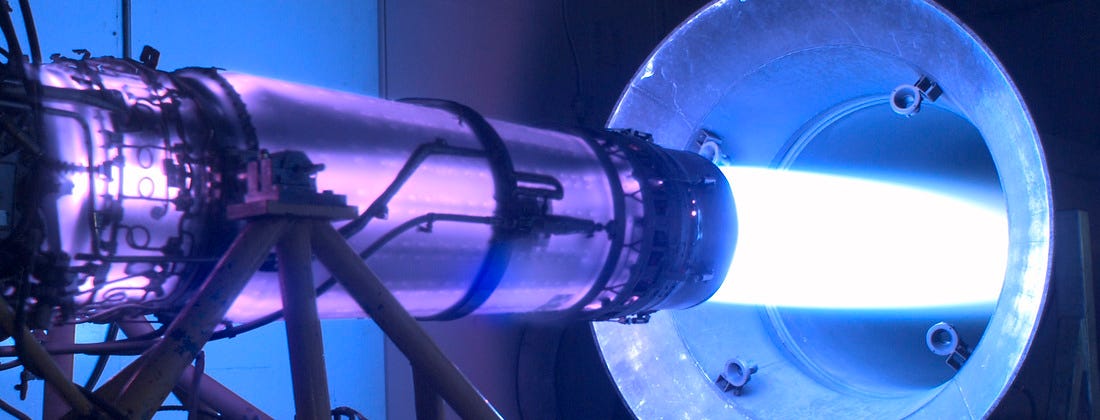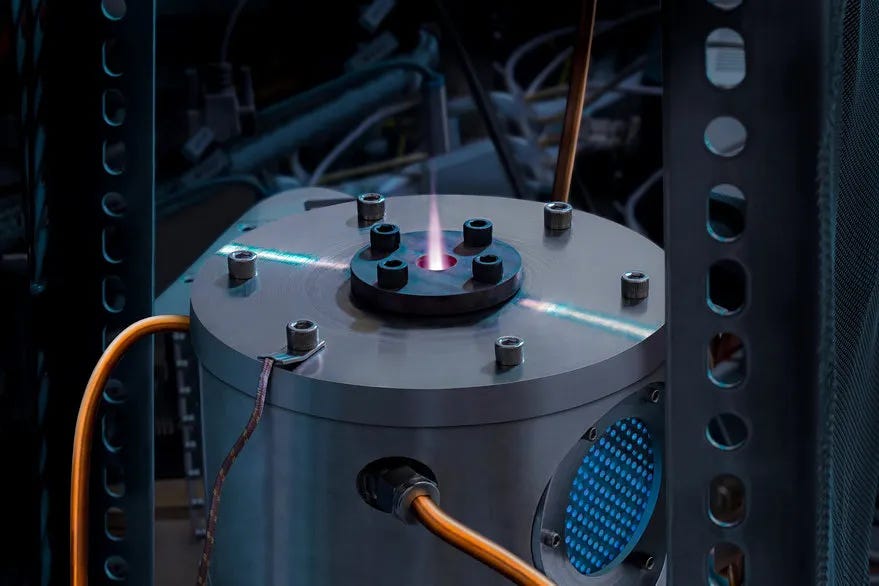Jet Propulsion: Evolution of Technology & the Future of Interplanetary Travel. Part 1.
As we celebrate International Day of Human Space Flight (12th April), let's explore the fascinating world of jet propulsion - the driving force behind mankind's journey into the cosmos.
Issue No 31. Subscribers 5353.
The key to space
On April 12th, 1961, Yuri Gagarin bravely ventured into space, opening up new frontiers for humanity. This groundbreaking event is commemorated globally to honor the courage and achievements of astronauts and space pioneers.
One of the most crucial technologies enabling humanity's foray into space is jet propulsion. Although we have been venturing into space for over six decades, the underlying physical principles remain the same. We have mastered jet propulsion in various forms, learned control techniques, and experimented with different implementations for diverse propellant components, resulting in a multitude of types of engines. At Space Ambition, we delved into the current state of the propulsion market to understand it in detail.
The two driving forces in astronautics today are the evolution of multi-satellite constellations and the subsequent rise in launch numbers. These factors are propelling the growth and advancement of the propulsion market.
The Satellite Propulsion System Market (propulsion systems for satellites orbit adjustment, maintenance, and deorbiting), valued at USD 2.18 billion in 2021, is expected to grow to USD 3.76 billion by 2030, with a compound annual growth rate (CAGR) of 6.51% from 2023 to 2030. Additionally, the Rocket Propulsion Market (propulsion systems for launching satellites, manned spaceflight, and deep-space missions), which was worth USD 5.2 billion in 2022, is projected to reach USD 12.3 billion by 2030, exhibiting a CAGR of 7.67% during the same period. Engine production complexities and high costs have been major factors hindering market growth, contributing to the relatively low CAGR. However, innovations such as 3D printing technology and composite materials have the potential to streamline engine manufacturing, with some of these advancements already being implemented.
Jet Propulsion 101
Jet propulsion is a method of propelling an object, typically an aircraft or spacecraft, by expelling a high-speed jet of mass, usually a gas, in the opposite direction of the desired movement. It operates on the principle of Newton's third law of motion: for every action, there is an equal and opposite reaction. Thrust is the force generated by a propulsion system, such as an engine or a thruster, to move an object forward. In the context of aerospace, thrust is the force that propels a rocket or spacecraft through the air or space, counteracting drag, gravity, and other forces. It is typically produced by expelling mass (such as exhaust gases in a jet engine or combustion products in a rocket engine) in the opposite direction of the desired motion. An engine is a broader term encompassing various types of machines that convert energy into motion, while a thruster (or rocket engine) is a specific type of propulsion device designed for control and maneuverability, particularly in spacecraft and satellites.

The primary characteristic of space flight is the speed of spacecraft, making it crucial for engines to alter either the magnitude of speed or its direction.
High vs. Low Thrust Engines: Velocity and Efficiency in Space Travel
Engines can generally be classified as high or low thrust.
High-thrust engines operate for brief periods, providing substantial thrust instantaneously, allowing for rapid and significant changes in speed. However, these maneuvers consume considerable amounts of fuel.
On the other hand, low-thrust engines can run for hours or even days, gradually increasing speed with each passing second while using minimal fuel. This approach trades time for fuel efficiency, with some nuances involved.

Jet Engine Applications: Launch, Orbit Adjustments, and Satellite Maneuvers
The selection of a jet engine relies heavily on specific mission requirements.
For instance, compact CubeSats (small, lightweight satellites typically built using a standardized cubic design with each unit, measuring 10x10x10 centimeters) that don't necessitate any control and are transported to their target orbit by rockets might not need engines at all. Rockets that deploy satellites are equipped with powerful thrusters to counteract gravitational forces. For missions that demand high-precision orientation, low-thrust engines are often employed, as minor adjustments can be accomplished without significant power output.
Consequently, the task at hand dictates the choice of a suitable engine or a combination of engines.
Key applications of jet engines include:
Launching from the ground to the target orbit demands high-thrust engines to counteract gravity.
Transitioning between orbits often requires considerable energy (which means high-thrust).
Deploying satellite constellations, where reaching target orbits quickly is essential to avoid wasting time and money. Low-thrust engines can be useful, but efficiency is crucial.
Collision avoidance in urgent cases, where rapidly changing trajectories is necessary as quickly as possible, high-performance engines or low-thrust engines with high efficiency are needed.
Orbit maintenance, also known as station-keeping, involves utilizing small thrusters to counteract minor disturbances in a satellite's orbit. When a satellite performs one corrective maneuver per week, the total number of corrections for a large constellation of satellites can accumulate to thousands per month.
Deorbiting is a task mandated by the Federal Communications Commission, which can be achieved gradually using low-thrust engines.
High-thrust Rocket Engines
High-thrust engines are mainly used for launching, which we've covered in a separate article. The primary categories of high-thrust engines encompass those that utilize:
Liquid propellant engines utilize a mixture of two liquid fuel components that are combined and combusted, producing high-velocity gas that exits through the nozzle. These engines, such as SpaceX's Merlin, Rocket Lab's Rutherford, and the Ariane rocket's HM7B, can be ignited and extinguished multiple times.
Solid propellant engines, on the other hand, consist of a single component, similar to gunpowder, which burns entirely. This type of engine can only be ignited once, as demonstrated by the Zefiro engine used in the Vega-C rocket.
Hybrid systems integrate both liquid and solid propellants to capitalize on the advantages of each type.
The landscape for high-thrust engines is quite fascinating, as companies tend to build entire rockets rather than just sell the engines. There are only a few startups that solely produce engines for sale, such as Ursa Major (total funding of $134 million), Firehawk (which develops a hybrid engine using 3D-printed solid fuel, total funding $21.5 million), and Aerojet Rocketdyne (planned to be acquired by Lockheed Martin with a 4.4 $billion deal, but the agreement was terminated). We identified several reasons for this trend: a rocket's design is closely connected to its engine, making it challenging to integrate new engines. Consequently, companies often prefer to control the entire rocket design process, including the engine. Moreover, such engines may have dual-use applications, and private companies might not align with national security objectives.
We spoke with Simon Gwozdz, CEO of Equatorial Space, a Singapore-based launch company that recently raised $1.5 million in seed funding to construct a new launch vehicle. Initially, they intended to develop engines but later shifted their focus to rockets. Gwozdz shared his perspective: "We're not opposed to selling propulsion units under the right conditions, but it's evident that there's a bottleneck in launch capacity, and we decided to concentrate on addressing that issue."

Low-thrust Rocket Engines
To correct the orbit and avoid collisions one uses low-thrust engines. Diversity is relatively widespread in this field, as the growing demand for satellite technology spurs innovation. Various methods and technologies are being explored, attracting significant investments and the emergence of new players in the industry.
There are various types of low-thrust rocket engines, such as electric, plasma, liquid propellant, and cold gas thrusters. Each type offers unique advantages and drawbacks, making them ideal for specific missions or spacecraft needs.
For instance, there are examples of start-ups building different types of low-thrust engines:
Exotrail raised $58M to scale up, utilizing Hall-effect technology (a type of electric propulsion that uses magnetic and electric fields to accelerate ions, creating thrust) for their Spaceware engine.
Busek has been developing hall-effect thrusters since 1985, one of the market leaders, has supplied thrusters to NASA
Morpheus secured a $28M round while developing low-thrust Go-Multi engines based on Field-emission electric propulsion (FEEP) technology (a method that generates thrust by accelerating charged particles, typically ions, using strong electric fields in a small, efficient system)
Momentus, with total funding of $144M, developed its in-space infrastructure service engine using Microwave electrothermal thruster (MET) technology (a type of propulsion system that uses microwaves to heat a propellant, creating high-pressure gas that is expelled through a nozzle to generate thrust)
Accion Space raised $83.5M by creating engines based on Tiled ionic liquid electrospray (TILE) technology (a propulsion system that uses tiny, electrically charged droplets of an ionic liquid to create thrust, offering precise control and high efficiency for small spacecraft and satellites)
Emerging players like IENAI have found innovative solutions for electrospray technology (a propulsion method that uses electric fields to generate and accelerate charged particles, typically in the form of tiny droplets, to produce thrust), already planning its application to the Atlantic satellite constellation.
We will explore the advantages and disadvantages of each technology in greater detail in one of the subsequent articles.
Non-traditional solutions
Technology continues to advance, and innovative non-traditional solutions are emerging. For instance, Pale Blue has developed a water-based low-thrust engine. This technology will be implemented in Sony's Star Sphere 1 satellite constellation.
Surprisingly, low-powered propulsion doesn't always require fuel! Sunlight itself can exert pressure, so deploying sails, much like a ship at sea, can provide the necessary thrust. This technology was successfully tested in 2019 by the Planetary Society's LightSail 2 mission. The mission utilized a 32-square-meter (244-square-foot) mylar sail to raise a small CubeSat spacecraft's orbit by 1.9 miles (3.2 km). Such technology can be used for flights outside our galaxy - such a project is being done by the company Breakthrough Starshot.
Extensive research is being carried out to explore various advanced propulsion technologies, such as nuclear thermal and electric propulsion, magnetic sail and Bussard ramjet. We will delve into these and even purely hypothetical concepts like wormholes or warp engines in one of the upcoming posts.
Our analytical center has conducted extensive research and compiled a comprehensive database of existing low-thrust and high-thrust engines. If you are interested in accessing this data, please don't hesitate to contact us.
IdeaFest: the future of propulsion
As we conclude this article, we invite you, our readers, to share your thoughts and ideas on the future of jet propulsion and space exploration. We're excited to hear about your vision for humanity's journey into the cosmos and how we can work together to achieve these ambitious goals.
To encourage a lively and thought-provoking discussion, we propose the following thought experiment:
Imagine it's the year 2050, and we've successfully established a sustainable human colony on Mars. Jet propulsion technology has advanced significantly, enabling faster and more efficient interplanetary travel. Describe the key propulsion innovations that you believe have made this possible and explain how they have impacted various aspects of space exploration, including satellite deployment, space tourism, and deep-space missions.
Please share your ideas in the comments section below, or email us at alexandra@spaceambition.org. We look forward to engaging in a fascinating conversation about the limitless potential of jet propulsion technology and its role in shaping our future among the stars.











One day I had an idea: a huge electromagnetic accelerator located at the equator. The outlet of the accelerator rests on the top of the mountain. A spacecraft with an external fuel tank accelerates to supersonic speed. A laser or microwave beam from space stations equipped with solar panels or nuclear reactors transfers energy to the spacecraft's engines. Several power stations pass the spacecraft to each other like a seasoned basketball team. The spacecraft goes into orbit and the fuel tank lands on the water and can be reused. If the fuel is ordinary water, we will get the "first space steam locomotive" :)
To answer your question, I think its unlikely that we will invent a new type of propulsion not yet conceived, but that we could very well revive those deemed impractical in the past. My vote is for Nuclear Thermal Propulsion. https://www.lianeon.org/p/how-the-atom-can-split-martian-travel
With an ISP of 900, we can do a lot.